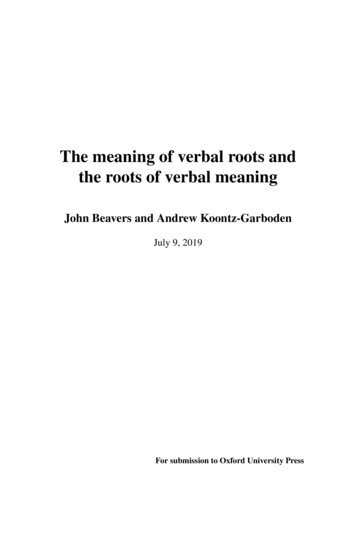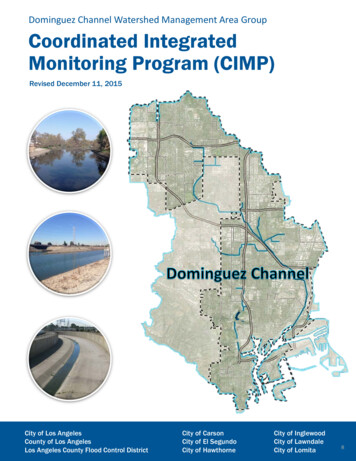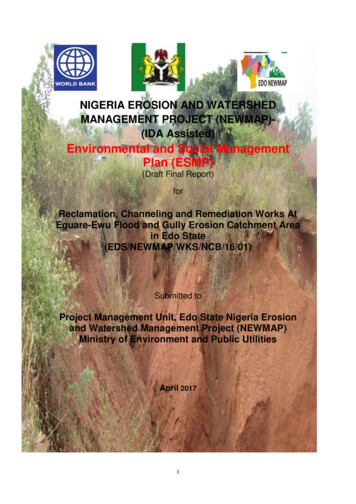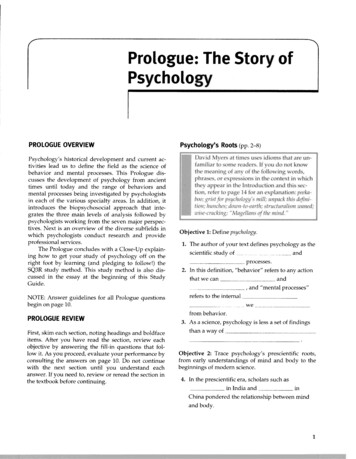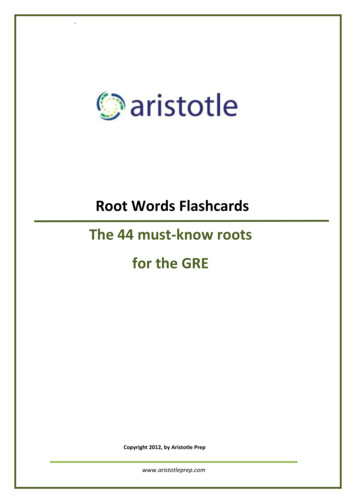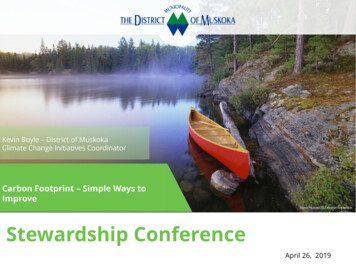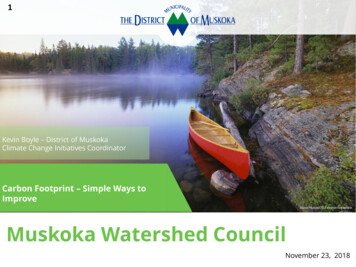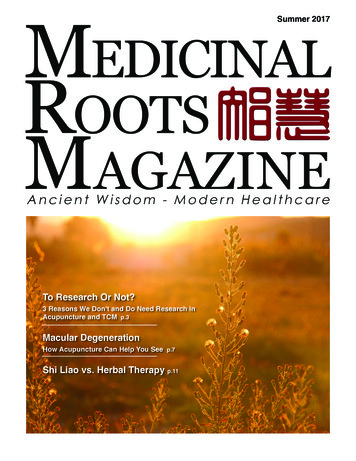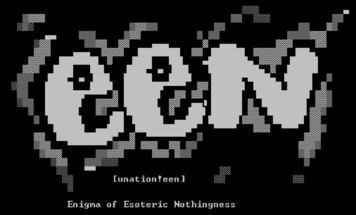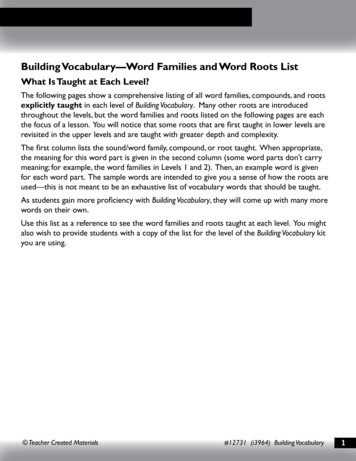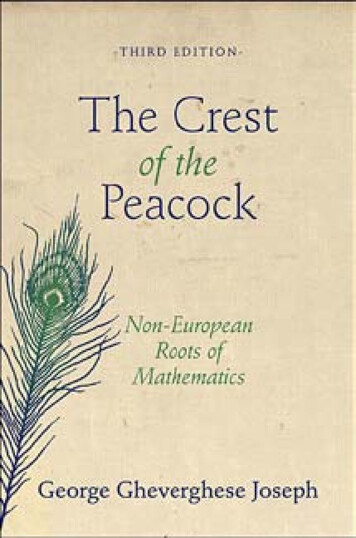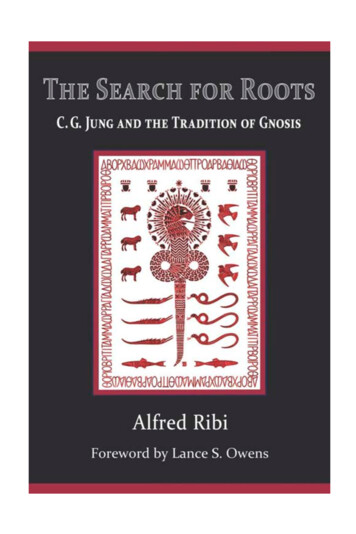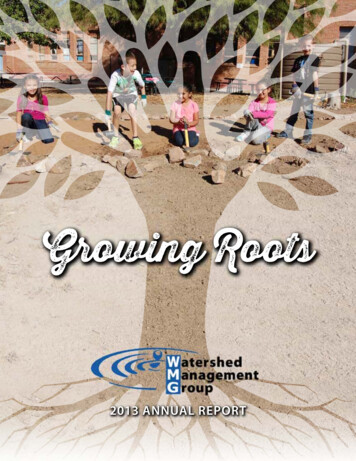
Transcription
Growing Roots2013 ANNUAL REPORT
Board of DirectorsDavid Stevenson, PresidentJoan Hall, SecretaryJennifer Mills, TreasurerGeorgia EhlersJames KircoffAmy McCoyIrene RadilloAdvisory BoardChris BrooksEvan CanfieldKevin DahlMark MurpheyGrowing Roots With YouA tree is only as strong as its roots. That’s why we are buildinglong-term programs, a sound business model, and a communityeducational center in Tucson. With your help, we will ensureour organization has the capacity and longevity to tackle thechallenges of the day and be a leader in conservation andcommunity building. Your investment in WMG as a donor hasnourished our roots — so with a hearty thanks and gratitude,we present our 2013 annual report!-WMG Staff and BoardStaffLisa Shipek, Executive DirectorBecky Blacher, Project ManagerJames DeRoussel, Program ManagerTim Fulton, Associate DirectorTrevor Hare, Project ManagerSky Jacobs, Administrator and IT ManagerBrad Lancaster, Sr. Watershed SpecialistJoaquin Murrieta-Saldivar, Project ManagerKarilyn Roach, Program and CommunicationsCoordinatorCatlow Shipek, Sr. Program ManagerKieran Sikdar, Project ManagerJoe Silins, Project ManagerRyan Wood, Program ManagerAnnual Report CreditsWriting: Lisa Shipek and Tim FultonEditing: Karilyn Roach and Lisa ShipekGraphic Design: Cero Wood Graphic Design, Inc.1Watershed Management Groupdevelops and implements communitybased solutions to ensure thelong-term prosperity of peopleand health of the environment.We provide people with theknowledge, skills, and resourcesfor sustainable livelihoods.
Direct Impact ofYour Dollars 50 DONATIONsponsors one tippy tap at a child’s home in Indiawith a follow-up visit See Page 13 100 DONATIONpays for educational signage at a public demonstration siteSee Page 12 250 DONATIONsubsidizes the cost to build a compost toilet barrel systemand stop flushing away resources See Page 9 –10 450 PAYMENT FOR ALANDSCAPE MASTER PLANsubsidizes workshops for low-income members of theGreen Living Co-op in Tucson or Phoenix See Page 3 – 4 1,000 DONATIONfunds a WMG expert to participate in stakeholder groups to advocatefor green technology or sound water policy See Page 11 3,000 CAPITAL CAMPAIGNCONTRIBUTIONfunds the creation of outdoor classrooms and the educational centerat the Living Lab and Learning Center See Page 6 – 8 5,000 PAYMENT FOR YOURBUSINESS’ LANDSCAPE MAKEOVERsubsidizes work with a K –12 school to create anoutdoor classroom rain garden See Page 52
Your Landscape DesignFunds Educational ProgramsAs a donor, we know it’s always exciting to invest in new initiatives, whether it’s a ground-breaking new program, aninnovative one-time project, or urgent advocacy work. Because we value your investment and continually strive to push theenvelope, we are creating new business models to sustain our ongoing programs. Enter: our fee-based programs. Our mostrobust fee-based program is the Green Living Co-op in Tucson and Phoenix. While new Co-op services are still supportedby your donations, our standard services are funded through our fee structure. To keep our services affordable for everyone,we offer discounted rates to those who volunteer, a special low-income rate, and many opportunities to apply for grants andsubsidies.We are expanding our fee-based services for both businesses and homeowners through our new Design to Buildoption. You can hire WMG to create a conceptual design for your landscape and oversee contractors to implement the plan –making the most of our unique expertise. These services contribute to WMG’s profit margin, allowing us to invest in our publiceducational programs, policy work, and programs benefiting low-income and minority communities.3
Meet our Design andConsulting Team:Catlow ShipekOur senior consultant withthe greatest depth and breadthof expertise, Catlow can helpyou with technical rainwaterharvesting systems, backyard tohomesteader makeovers, or solvingyour flooding or erosion problems.James DeRousselOur registered landscapearchitect and certified arborist,James specializes in working withcontractors, code compliance,and turning technical waterharvesting projects into beautifullandscapes.Becky BlacherOur landscape architect andenvironmental educator witha creative flare, Becky will helpyou realize your dreams throughboth an artistic and functionallandscape plan.Ryan WoodTucson Co-opServes UpPancakesand RebatesThe Tucson Co-op continues to offer newresources and build community in fun—anddelicious—ways. The Co-op now providesfree rainwater harvesting rebate classesevery 1-2 months to help Co-op membersand the general public gain the knowledge,skills, and resources to qualify for TucsonWater’s rainwater harvesting rebate of up to 2,000. All of WMG’s Co-op services for waterharvesting qualify for the rebate—from ourdesign time to project management to thecost of materials.Instead of wielding shovels and pick axes,Co-op members banded together withspatulas to serve up over 1,000 pancakes ata Mesquite Pancake breakfast in November.The fundraising event was part of the annualDunbar Spring Mesquite Fiesta – a mesquitemilling and celebration of local foodsorganized by Dunbar Springs neighborhoodand non-profit Desert Harvesters. Co-opmember and chef Janet Taylor created thepancake recipe featuring local mesquiteflour, heritage Sonoran wheat, and localeggs. A big thanks to all the Co-op membersthat made the event a success!Our permaculture designerwith strong technical skills inwater harvesting, Ryan canhelp you design and implementyour projects with patience andprecision.On-site Consultations only 150Complete master plans for 450When you hire WMG, you hire a non-profit business thatgives back to your community and your environment.Visit http://watershedmg.org/consultationto learn more or schedule a consultation.Co-op volunteer serves mesquite pancake with prickly pear syrup4
WMG Partnership Profile:Tucson Association of RealtorsWMG staff member, James Deroussel, leads green streets installation workshop with Tucson Association ofRealtors and community volunteersWhat if our parking lots were more like parks? Instead of being an eyesore and major contributor to flooding and hot cities, they could capturestormwater, shade our streets, and beautify our neighborhoods. Withthis philosophy in mind, WMG worked in partnership with the TucsonAssociation of Realtors (TAR) to retrofit their 53,000 square foot parkinglot at their Tucson Boulevard headquarters.“The project demonstrates that small changes in our builtenvironment can make positive environmental change. The retrofit wasartfully designed, and its effects were not subtle: water that normallyran off the parking lot and flooded Tucson Boulevard was capturedby the newly designed landscape,” said John Mijac, Contract Managerwith Long Realty.TAR members and WMG volunteers installed basins and nativevegetation in the parking lot landscape buffer and along the neighboringstreet through two WMG workshops. New curb cuts harvest stormwateroff the parking lot and neighborhood street to irrigate the plants. Inaddition to reducing flooding, we are reducing the demand on municipalwater to establish new vegetation.Nicole Brule-Fisher, realtor at RE-MAX Trends, said environmental sustainability is important to TAR membership, andthis project demonstrates that to the community.She went on to say, “The TAR office is a dynamic location. We host a number of events and rent the facility out for manyfunctions, so a large number of people are able to see the project—which looks beautiful!”Congratulations to TAR for making the investment to improve Tucson’s watershed and reduce the impact of heatgenerated from their parking lot. We hope others are inspired by their great work!5
New Roots, Shoots, & Poopsat the Living Lab and Learning CenterWith the development of WMG’s Living Lab and Learning Center, we’re putting down roots at our 1137 N. Dodgeproperty in Tucson. Literally. With your help we’ve planted more than 100 native trees, shrubs, grasses, and wildflowers oncampus. And this is just the start!As the roots develop, new shoots are growing, fed by our rainwater-harvesting basins and irrigation from our rain tanks.Our latest landscape project is watered by greywater from a hand washing sink along with bleed off from the water filter inour staff break room. The fastest growing shoots are on the plants nourished by stormwater in our street-side basins—theseplants are known to grow 30% larger than plants on regular irrigation (thanks to University of Arizona’s Mitch PavaoZuckerman for sharing your stunning research on green infrastructure)!Along with the water, we’re harvesting all the poop—from visitors and staff alike—and composting it for the benefit ofour plants. Check out the article on our Soils Stewards program for the official poop scoop.Thanks to all of you who joined us to celebrate the Living Lab and Learning Center at our Garden Brunch and PlantingPachanga in November. The next big event we are hosting here is our Earth Day Festival and Watering Hole Happy Houron Saturday, April 19th. We hope to see you all there! Register online at watershedmg.org/earth-month-2014.Living Lab and Learning Center:Timeline of Property DevelopmentWildflowers bloom in abundance thanks to stormwater at theLiving Lab and Learning Center Inherited property from Marguerite Fisher, March 2012 Street front facelift with stormwater-harvesting basins and nativeplants, October 2012 Purchase of neighboring property with lead capital donation,March 2013 Construction of office compost toilet with state permit, March 2013 10,000-gallon underground cistern constructed with Tucson Watergrant, October 2013 Landscape perimeter overhaul with earthworks, shade trees, andhabitat, November 2013 Special Exception Zoning Status Achieved, December 2013WMG volunteers and donors enjoy the Garden Brunch and Planting Pachanga6
Half a Million & Half Way There—Thanks to YouWMG is raising 1 million dollars to fund the development of the Living Lab and Learning Center in Tucson. Weare honored by all the people and businesses that contributed to our capital campaign in 2013 to support these greataccomplishments: Creation of a master plan with architect Dave Shambach Approval of our “Cultural Use” zoning exception by Tucson Mayor and Council, enabling us to use our residentialproperty as a public educational center Designing and installing our rainwater harvesting landscape and native habitat zonesThe half million raised to date includes the lead gift of the bequest of property and an investment fund from MargueriteFisher. A second lead gift from another donor allowed us to purchase the neighboring property, more than doublingour office and classroom space. With the ownership of both properties secured—mortgage-free—and a waiver onproperty taxes, we’re well-positioned to realize this dream with you.There will be many opportunities to give and participate in the development of the educational center. With still 450,000 to raise, we will continue to raise funds through various capital campaign efforts throughout the year. We aredepending on donors to make additional gifts of cash, stocks, or estate gifts, along with attracting new support fromindividuals, businesses, and foundations.A capital campaign is a designated campaign, where all donations are used towards a capital project. We are running thecapital campaign in addition to our annual fundraising, which supports our program work.If you are interested in learning more or want to make a gift to our capital campaign,please contact Lisa Shipek at 520-396-3266, or visit watershedmg.org/capital.7
Conceptual vision of WMG’s Living Lab and Learning CenterWith your continuedsupport, we will beworking on theseprojects in 2014: Training youth out of juveniledetention to create a food forest withfruit trees and greywater systems Creating outdoor classrooms and thecentral plaza for our educational andsocial events Installing a green parking lot for bothcars and bikes that drains into a largeswale to grow shade trees Designing and installing a Native FoodHeritage Garden in honor of the lateMarguerite Fisher, which will alsobe a pocket park for the Palo Verdeneighborhood to use Creating a playhouse where childrenwill be able to use water from therain tank in the kitchen, watch howgreywater plumbing works, and sandbox with earth shaping tools to learnabout how water flowsDAVID E. SHAMBACH, ARCHITECT, INC.Three Cheers for ourCapital Campaign Donors!Capital CampaignDonorsKim & Jim AfinowichJulie Hall AllisonRosemary AndersonMatthew BertrandKatherine BrownRoss BryantCarl KanunJames CarpenterBill & Robin CharlesCharles & Carol ColeCatherine CompagnoDouglass & Jeanne CookCat CrawfordEmily Creigh & Tom PoleyKevin Dahl & Bam MillerLucy Del GiorgioSuzanne & Eric DhruvJohn Douglass & Jill OnkenGeorgia EhlersDebra EinweckJulie EvansNancy EvansRon & Bonnie EwingIrene FarrowVictoria & Mark FosterTim FultonJoan HallDouglas HenleyHeather HiscoxHenry & Ruth JacobsonSusanne KaplanDavid KieferDavid KohlbergMichael KriskovicArthur MacDonald & SallyShermanAmy McCoy & BrianAndersonCarol McCrearyBob Mellon & NancyWarshawerDan & Jennifer MillsCathy MullanShirley MuneyMark MurphyJennifer & Chris PhillipsGerman QuirogaIrene RadilloGene & Jean RamsayBusiness and Foundation DonorsAlexander-Carrillo ConsultingDave E. Shambach ArchitectsLong Realty CompanyLoren Robertson & BenThompsonStephanie RobertsonAmy SalvatoSusan SargentCatlow & Lisa ShipekDavid Shipek & MelissaDeFoorDoreen SikdarKieran Sikdar & Corin MarronTina & Thomas SleeperVincent SteinerStephen HughesDavid StevensonDave StewartPatrick Stirling & JanetZampieriAnna TylerJohn VillinskiJoan WarfieldWilliam WilkeningRyan Wood & Ericka CeroWoodJeff & Connie WoodmanRoss ZimmermanSouthwestern FoundationTucson Water8
Instead of Flushing, WeCreate Class A CompostWho would have known that so many people are interested in compostingtoilets? Well, we had a sneaking suspicion, but we were pleasantly surprisedby the large interest in our Soil Stewards program and installing compostingtoilets in urban Tucson and beyond.Since we started the pilot program with 20 state-permitted toilets, we’ve hadan overwhelming number of requests to build and help permit compostingtoilets. Unfortunately, we can’t move on this interest until our compostingtoilet designs are officially approved reference designs by the ArizonaDepartment of Environmental Quality.We recently cleared a major hurdle in the process to legalize these toilets for all Arizonans. Our partners at the Universityof Arizona Microbiology lab tested samples from all the pilot toilets for fecal coliforms and salmonella. The results are nowin—and all the composted humanure samples are rated as EPA Class A biosolids—safe to use in your yard.Would you like to see and experience one of these toilets firsthand? Just visit WMG’s Living Lab and Learning Center inTucson. We invite you to make your contribution—and we will turn it into nutrients for our edible garden! Currently oneof the state-permitted barrel systems is the primary office toilet, and this spring at the Living Lab we’re planting fruit treesand other edible plants that will benefit from all this great compost!In addition to creating a rich compost resource, we’re also saving other precious resources by using this toilet. Since westarted using it in March 2013, we have saved 400 gallons of water and 4 kWh of energy (enough energy tolight a 40-watt bulb for 100 hours) each month by not flushing the toilet!Finished humanure compost iseasy and safe to use in your yard9
Want to learn more? Through U.S. Environmental Protection Agency funding, we have also developed educationalmaterials to help you turn common wastes into resources. Our “How to Build a Composting Toilet Barrel System” videohad 65,000 views in the first year of posting! Visit watershedmg.org/soil-stewards to watch it and check out our newestvideo, “Waste Into Resources” featuring Brad Lancaster.Partner Profile: Diane Austin,University of Arizona:Bureau of Applied Researchin AnthropologyQ: Why did the UA Bureau of Research inAnthropology (BARA) want to partner withWMG on the Soil Stewards program?BARA has a unique connection with WMGsince several WMG leaders, staff, and supportersparticipated in BARA’s internship program whilethey were students at the University of Arizona.In 2007, we began helping develop and carryout a composting toilet program in Nogales,Sonora in partnership with the Asociación deReforestación en Ambos Nogales (ARAN) andthe Nogales municipal government. Sincethen, we had been interested in a similarprogram for southern Arizona. BARA becameinvolved in the Soil Stewards program in theearly stages in order to help conceptualizeAnthropology student collects information from Soil Steward participants tothe experimental composting toilet pilotmonitor and evaluate program success.project. We were very pleased to help WMGtake this next step.Q: Briefly describe your role in the program.Once the program was funded, BARA’s role shifted to participating on the advisory boards of thecomposting toilet and neighborhood mulching projects as well as developing and leading themonitoring and evaluation activities throughout the program.Q: What has been the biggest surprise in the program’s implementations?We initially expected the mulching project to be a more central aspect of the program and that thecomposting toilets would be of interest to fewer people. Instead, from the first informational sessions, it hasbeen the reverse.Q: What potential do compost toilets have to be more widely adopted in Tucson/Southwest/US?Under conditions of water scarcity, residents, leaders, and institutions will become more open to a varietyof alternatives. Composting toilets can be developed for individual households and workplaces and scaledup for apartment complexes and office buildings. Also, there are many composting toilet models and withcareful matching of design and purpose they can be adapted for a wide variety of users.Q: Anything else you want to share?Special thanks to the WMG leaders and staff and especially to the Soil Stewards; without their willingness toexplore, experiment, and reflect on their experiences this project would not have been possible.10
Emerald City Provides Blueprintfor the Region (and Beyond)Tucson’s leadership in water harvesting and green infrastructure continuesto grow with the passing of the Green Streets policy that WMG co-developedwith the mayor’s office in 2013. And people around the country are takingnote: recently the Natural Resources Defense Council awarded Tucson itsEmerald City status for the green streets policy and rainwater harvesting rebateprogram.Putting a policy on the books is a big accomplishment, but ensuring thepolicy is successfully implemented is the real work. WMG is committed toseeing it through.We are in the final stages of developing a best practices manual to implementthe Green Streets policy that will be a resource for the Department ofTransportation and engineering and landscape architecture firms.Laura Mielcarek, a local landscape architect with Wheat Scarf Associates,said they are successfully following the process outlined in the Green Streetspolicy for the large-scale redevelopment of Grant Road that is currentlyunderway.WMG’s latest collaboration with the Tucson Department of Transportationis the creation of a shade tree plan for one of Tucson’s newly designated “BikeBoulevards.” We are working with residents and an elementary school alongthe route to help shade the Treat Avenue Bike Boulevard and make it a morecomfortable and beautiful street for pedestrians and cyclists.Volunteers build infiltration basin at Tucson’s Ward 1 City Council Office11Designs from WMG’s best practices manualWMG staff are being asked toshare their expertise with othercities, frequently presenting inthe Phoenix region and NewMexico, along with
architect and certi ed arborist, James specializes in working with contractors, code compliance, and turning technical water-harvesting projects into beautiful landscapes. Becky Blacher Our landscape architect and environmental educator with a creative are, Becky will help you realize your dreams
